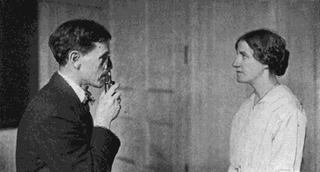Related Research Articles

A corrective lens is a lens that is typically worn in front of the eye to improve daily vision. The most common use is to treat refractive errors: myopia, hypermetropia, astigmatism, and presbyopia. Glasses or "spectacles" are worn on the face a short distance in front of the eye. Contact lenses are worn directly on the surface of the eye. Intraocular lenses are surgically implanted most commonly after cataract removal but can be used for purely refractive purposes.

Contact lenses, or simply contacts, are thin lenses placed directly on the surface of the eyes. Contact lenses are ocular prosthetic devices used by over 150 million people worldwide, and they can be worn to correct vision or for cosmetic or therapeutic reasons. In 2010, the worldwide market for contact lenses was estimated at $6.1 billion, while the US soft lens market was estimated at $2.1 billion. Multiple analysts estimated that the global market for contact lenses would reach $11.7 billion by 2015. As of 2010, the average age of contact lens wearers globally was 31 years old, and two-thirds of wearers were female.

Near-sightedness, also known as myopia and short-sightedness, is an eye disease where light focuses in front of, instead of on, the retina. As a result, distant objects appear blurry while close objects appear normal. Other symptoms may include headaches and eye strain. Severe near-sightedness is associated with an increased risk of retinal detachment, cataracts, and glaucoma.

Optometry is a specialized health care profession that involves examining the eyes and related structures for defects or abnormalities. Optometrists are health care professionals who typically provide comprehensive primary eye care.

Stereoscopy is a technique for creating or enhancing the illusion of depth in an image by means of stereopsis for binocular vision. The word stereoscopy derives from Greek στερεός (stereos) 'firm, solid', and σκοπέω (skopeō) 'to look, to see'. Any stereoscopic image is called a stereogram. Originally, stereogram referred to a pair of stereo images which could be viewed using a stereoscope.

The Bates method is an ineffective and potentially dangerous alternative therapy aimed at improving eyesight. Eye-care physician William Horatio Bates (1860–1931) held the erroneous belief that the extraocular muscles effected changes in focus and that "mental strain" caused abnormal action of these muscles; hence he believed that relieving such "strain" would cure defective vision. In 1952, optometry professor Elwin Marg wrote of Bates, "Most of his claims and almost all of his theories have been considered false by practically all visual scientists."
Orthoptics is a profession allied to the eye care profession. Orthoptists are the experts in diagnosing and treating defects in eye movements and problems with how the eyes work together, called binocular vision. These can be caused by issues with the muscles around the eyes or defects in the nerves enabling the brain to communicate with the eyes. Orthoptists are responsible for the diagnosis and non-surgical management of strabismus (cross-eyed), amblyopia and eye movement disorders. The word orthoptics comes from the Greek words ὀρθός orthos, "straight" and ὀπτικός optikοs, "relating to sight" and much of the practice of orthoptists concerns disorders of binocular vision and defects of eye movement. Orthoptists are trained professionals who specialize in orthoptic treatment, such as eye patches, eye exercises, prisms or glasses. They commonly work with paediatric patients and also adult patients with neurological conditions such as stroke, brain tumours or multiple sclerosis. With specific training, in some countries orthoptists may be involved in monitoring of some forms of eye disease, such as glaucoma, cataract screening and diabetic retinopathy.

Presbyopia is physiological insufficiency of accommodation associated with the aging of the eye that results in progressively worsening ability to focus clearly on close objects. Also known as age-related farsightedness, it affects many adults over the age of 40. A common sign of presbyopia is difficulty reading small print which results in having to hold reading material farther away. Other symptoms associated can be headaches and eyestrain. Different people will have different degrees of problems. Other types of refractive errors may exist at the same time as presbyopia. This condition is similar to hypermetropia or far-sightedness which starts in childhood and exhibits similar symptoms of blur in the vision for close objects.

An eye chart, or optotype, is a chart used to subjectively measure visual acuity. Eye charts are often used by health care professionals, such as optometrists, physicians or nurses, to screen persons for vision impairment. Ophthalmologists, physicians who specialize in the eye, also use eye charts to monitor the visual acuity of their patients in response to various therapies such as medications or surgery.

Refractive error, also known as refraction error, is a problem with focusing light accurately on the retina due to the shape of the eye and or cornea. The most common types of refractive error are near-sightedness, far-sightedness, astigmatism, and presbyopia. Near-sightedness results in far away objects being blurry, far-sightedness and presbyopia result in close objects being blurry, and astigmatism causes objects to appear stretched out or blurry. Other symptoms may include double vision, headaches, and eye strain.
Vision therapy (VT), or behavioral optometry, is an umbrella term for alternative medicine treatments using eye exercises, based around the pseudoscientific claim that vision problems are the true underlying cause of learning difficulties, particularly in children. Vision therapy has not been shown to be effective using scientific studies, except for helping with convergence insufficiency. Most claims—for example that the therapy can address neurological, educational, and spatial difficulties—lack supporting evidence. Neither the American Academy of Pediatrics nor the American Academy of Ophthalmology support the use of vision therapy.
Convergence insufficiency is a sensory and neuromuscular anomaly of the binocular vision system, characterized by a reduced ability of the eyes to turn towards each other, or sustain convergence.
An eye care professional (ECP) is an individual who provides a service related to the eyes or vision. It is any healthcare worker involved in eye care, from one with a small amount of post-secondary training to practitioners with a doctoral level of education.

Fixation disparity is a tendency of the eyes to drift in the direction of the heterophoria. While the heterophoria refers to a fusion-free vergence state, the fixation disparity refers to a small misalignment of the visual axes when both eyes are open in an observer with normal fusion and binocular vision. The misalignment may be vertical, horizontal or both. The misalignment is much smaller than that of strabismus. While strabismus prevents binocular vision, fixation disparity keeps binocular vision, however it may reduce a patient's level of stereopsis. A patient may or may not have fixation disparity and a patient may have a different fixation disparity at distance than near. Observers with a fixation disparity are more likely to report eye strain in demanding visual tasks; therefore, tests of fixation disparity belong to the diagnostic tools used by eye care professionals: remediation includes vision therapy, prism eye glasses, or visual ergonomics at the workplace.
George Jessen (1916–1987) was an optometrist who was an early pioneer of the contact lens. He is credited with being one of the first to employ the concept of orthokeratology, a direct attempt to reduce refractive error with the use of a contact lens, under the term orthofocus.
Optometry is a health care profession that provides comprehensive eye and vision care, which includes the diagnosis and management of eye diseases.

The Art of Seeing: An Adventure in Re-education is a 1942 book by Aldous Huxley, which details his experience with and views on the discredited Bates method, which according to Huxley improved his eyesight.

Margaret Darst Corbett was an American who promoted the discredited Bates method in an attempt to improve eyesight. She became famous after her prosecution and acquittal on a charge of practicing medicine without a license. Ophthalmologists dismissed Corbett's ideas as quackery.
Adjustable focus eyeglasses are eyeglasses with an adjustable focal length. They compensate for refractive errors by providing variable focusing, allowing users to adjust them for desired distance or prescription, or both.

Stereopsis recovery, also recovery from stereoblindness, is the phenomenon of a stereoblind person gaining partial or full ability of stereo vision (stereopsis).
References
- 1 2 Rob Murphy; Marilyn Haddrill; Gary Heiting (May 2009). "The See Clearly Method & Other Programs: Do Eye Exercises Improve Vision?". AllAboutVision.com. Archived from the original on 2010-03-06. Retrieved 29 May 2009.
- 1 2 3
- Shin, Annys (6 November 2006). "Seeing the See Clearly Method for What It Is". washingtonpost.com . Retrieved 14 March 2009.
- ↑ See Clearly Method website as archived on Feb 9th 2004
- 1 2 Raz, A., Marinoff, G. P., Landzberg, K.S., & Guyton, D. L. (2004). "Substrates of negative accommodation" (PDF). Binocular Vision & Strabismus Quarterly. 19 (2): 71–74. PMID 15180591. Archived from the original (PDF) on 2014-06-03.
{{cite journal}}: CS1 maint: multiple names: authors list (link) - ↑ Raz, A., Marinoff, G. P., Zephrani, Z. R., Schweizer, H. R., & Posner, M. I. (2004). "See clearly: suggestion, hypnosis, attention, and visual acuity". International Journal of Clinical and Experimental Hypnosis. 52 (2): 159–187. doi:10.1076/iceh.52.2.159.28097. PMID 15115060. S2CID 30369560.
{{cite journal}}: CS1 maint: multiple names: authors list (link) - 1 2 Richards, David (August 2008). "See Clearly Method Investigation". Independent Investigations Group . Retrieved 29 May 2009.
- ↑ Mendenhall, Deborah (11 December 2001). "See Clearly and transcendental meditation". Pittsburgh Post-Gazette.
- ↑ Bildstein, Tracy M. (2005). "The Effectiveness of the See Clearly Method". The Ohio State University.
- 1 2 Mishori, Ranit (2006-09-12). "Eyeballing the Vision Workout". ISSN 0190-8286 . Retrieved 2023-07-13.
- ↑ Iowa Attorney General's petition
- ↑ Iowa Attorney General office press release, Feb. 23, 2006
- ↑ Staff. "Lawsuit Filed Against 'See Clearly Method'". www.reviewofoptometry.com. Retrieved 2023-07-13.
- ↑ Iowa Consent Judgment
- ↑ Iowa press release on consent decreee
- ↑ See Clearly Method Website as archived on 18th Dec 2006
- ↑ Muris' petition to be removed from probation Archived 2014-10-06 at the Wayback Machine